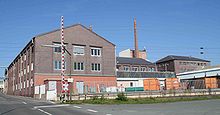Annawerk (Rödental)
The former Annawerk , today's Saint-Gobain Industriekeramik in the Rödental district of Oeslau in Upper Franconia , is a producer of ceramic products, mainly for technical needs.
history
On July 14, 1857, Joseph Rudolph Geith, who was then the leaseholder of the Coburg gas works , received the concession from the ducal state government in Coburg to build a brick and lime kiln , and also to manufacture siderolite and all goods made from clay and refractory earth can be manufactured. With the lime distillery, the supply of the gas works with lime for cleaning the wood gas and with the brick distillery the supply of firebricks for the production of luminous gas could be ensured more cheaply.
Due to the presence of clay and lime deposits in the vicinity and the planned Coburg – Sonneberg railway line , Geith chose the municipality of Oeslau as the location for the “Thonwaarenfabrik”. At the end of 1857, the factory started production on an area of 5000 square meters. The raw materials came initially from the clay pit in Kipfendorf and from 1930 from Spittelstein . The production included firebricks, bricks and burnt lime and plaster . It has been continuously expanded over time. From 1868 clay pipes were produced for the sewer system, in 1875 acid-resistant stoneware for the chemical industry was added, in 1879 roof tiles , 1889 sidewalk tiles , 1892 hard porcelain stones for mills and 1906 sanitary ware . The burning of lime was stopped in 1877.
In 1868 the factory was named Annawerk. It was named after Rudolph Geith's first wife, Anna Geith, who was born in 1866. Rudolph Geith died at the age of 62 on May 21, 1884. His second wife and son of the same name took over the management. In order to finance company expansions, the family renamed Thonwaarenfabrik JR Geith in Coburg into the joint stock company Annawerk Schamotte- und Tonwarenfabrik AG vorm. JR Geith around.
By 1907, the area of the plant had grown to 97,000 square meters and the workforce had grown to 320 workers. In 1915, instead of horse-drawn vehicles, a 600-millimeter-gauge mine railway to the Kipfendorf clay pit five kilometers away was put into operation, which ran until 1958. Before the First World War , the plant had 350 employees.
In 1935, Deutsche Steinzeugwarenfabrik Aktiengesellschaft ( Mannheim-Friedrichsfeld ) and Deutsche Ton- und Steinzeugwerke AG ( Krauschwitz ) took over a majority stake in Annawerk Schamotte- und Tonwarenfabrik AG in Oeslau at the instigation of the main shareholder Jacob Cremer, a stoneware pipe manufacturer from Frechen . 714 workers were employed at the Annawerk, two years later there were 900.
In June 1937, the Anna plant AG acquired to increase its raw material base, mining fields of the company "United Trade Union Schmidgaden black box" and co-founded in November of the same year with the Reichswerke the Buchtal AG , Ceramic companies in the realm works Hermann Goering, Oeslau in Schwarzenfeld in the Upper Palatinate for the production of refractory material. The main focus of production in World War II , which was classified as important for the war effort, was refractory firebricks, which were used in blast furnaces , among other things . There was no significant damage in the Second World War.
In 1957 the company celebrated its hundredth anniversary. At that time, around 900 workers were employed and on a factory site of 325,000 square meters there was around 120,000 square meters of production space. There were six factories in Oeslau for refractory materials, sanitary ware, stoneware pipes, slabs (formerly Alexandrinenthal plant , acquired in 1936), clinker and roof tiles (formerly Katharinawerk, acquired in 1898) and high-grade plaster . In 1966 the workforce comprised 1,000 people.
After the building ceramics works that were no longer profitable had been closed earlier, at the end of 1998 Deutsche Steinzeug Cremer & Breuer AG sold its subsidiary Annawerk Keramische Betriebe GmbH in Rödental , which was active in the field of high-performance ceramics with refractory materials (e.g. materials for the lining of waste incineration plants ) . The plant still had 340 employees and was acquired by SEPR Keramik GmbH & Co. KG , a subsidiary of the French Saint-Gobain group . In 2000 the name was changed to Saint-Gobain Industriekeramik Rödental.
present
In 2007, the largest employer in Rödental, Saint-Gobain IndustrieKeramik Rödental , employed 720 people. The factory produces and sells kiln furniture for the entire ceramic industry, special refractory products for metallurgy and ceramic diesel soot particle filters . The production of diesel particulate filters, which began in 2006, was shut down by the beginning of 2014, cutting 200 jobs.
literature
- Jochen Wistinghausen: A work and its people - the 100-year history of the Annawerk in Oeslau near Coburg; 1857 - 1957. Oeslau near Coburg, 1957.
Web links
- Annawerk A.-G. (Annawerk Oeslau b Coburg), Festschrift 80 years 1937
- Website of the Saint Gobain division Performance Ceramics & Refractories (English)
Individual evidence
- ↑ Neue Presse Coburg: 150 years Annawerk - Saint-Gobain stands for the Rödental location , June 28, 2007
Coordinates: 50 ° 17 ′ 31 ″ N , 11 ° 2 ′ 31 ″ E


